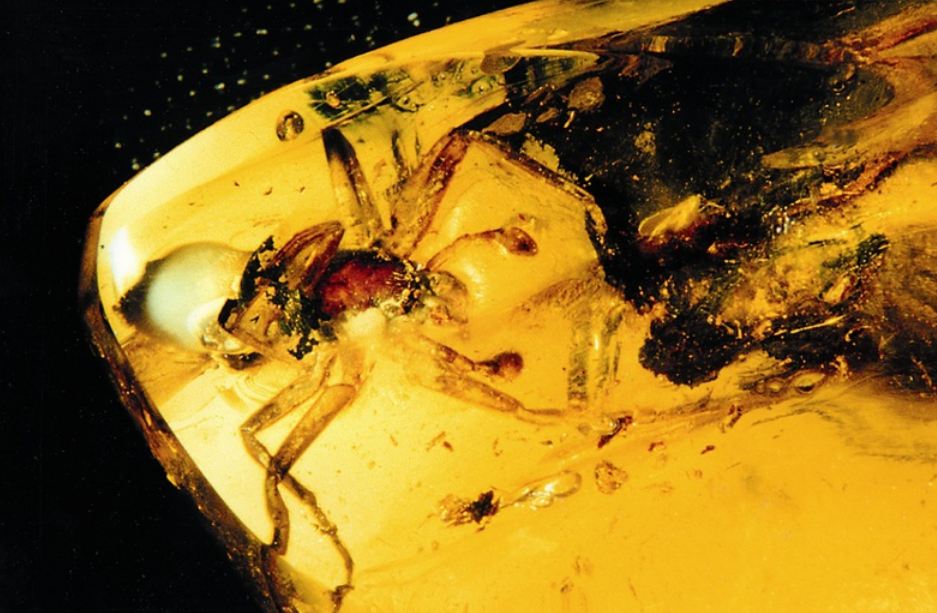| Main » Articles » About Baltic Amber |
 Wolfgang Weitschat (a professor of University of Hamburg Geology-Paleontology Istitute) Scientists are interested in amber because of the remains of flora and fauna. Amber inclusions are like snapshots made 50 million years ago, which give a possibility to study behavior of some species, the relationships between them. Insects got into the resin in unbelievable moments: laying eggs, mating, getting out of cocoons, spiders spinning their web or catching a prey; swarms of flies, mosquitoes or termites, which got into resin during wedding flights. Sticky and tacky resin became trap for insects, arachnid, and even lizards. Amber resin was very runny but got hardened when evaporated. Any trapped fly or ant remained preserved forever that‘s how inclusions were formed. Unlike other fossils, which were usually compressed by sediment, amber with inclusions is transparable on all sides. Earlier there were trials "to take out” a beautifully preserved inclusion. However, what a disappointment people experienced when the trial failed and the inclusion was destroyed. The reason is that the internal organs of trapped organisms are decomposed, but their surface structures survived to the smallest details: the tiniest hair and scales could be seen. Sometimes it seems you are looking at alive insects and not 50 million-year-old inclusions. It allows scientists to describe and identify flora and fauna of those times. If to compare currently existing species to the species which are in the inclusion morphologically, you can trace evolution of living organisms. About three thousands five hundred fossil fauna were found in amber, 10-15% of which are presently existing species of insects that have not evolved much since. Only small, mostly forest-living species can be found, because bigger insects were strong enough to escape and water-living insects rarely got entrapped. The insects that lived in dry places or did not fly in spring, when trees were exuding resin and processes of tree metabolism took place, are hardly found in amber. The fauna preserved in Baltic amber is almost exclusivery restricted to arthropods, with insects and arachnids making up a majority of nearly 99 %. Inclusions of other phyla (worms, molluscs, vertebrates) are extremmely rare. Only 9 species of land molluscs have been found in amber. The unique inclusion of snail's shell is exhibited in the Amber Museum-Gallery in Vilnius. Other arachnids found in amber are scorpions (they are very rare, perhaps only 11 of them were found) , pseudo-scorpions, opiliones, ticks and forest-living spiders. 100 species of ticks and 580 species of spiders have been found in amber. Of all arachnids found in amber most common "prisoners" were forest-living spiders that used to live on plants, under the bark. These are tropical and subtropical varieties. Spiders are 9% of found inclusions. Besides spiders, the products of their activity - fine webs with particles of wood or dew-drops, even their prey that got sucked and dried out - often occur in pieces of amber. A researcher J. Wunderlich from Hamburg University of Geology and the Palaeontology museum have found the first previously unknown species of spiders in the collection of inclusions. From now on this species of spiders will be called "Sosybius Mizgirisi", after the name of the owner. Insects (90%) form a great amount of all inclusions found in the Baltic amber. The most common ones are flies and mosquitoes. They make 45% of all found items. Currently there are 74 families with 800 species. Two more known species are hymenopteran, such as ants and small hornets (450 species), and bugs (140 species). The complete opposite of insects are fleas. There are 6 specimen known. Four species of fleas, which existed at that time, are detected. The first flea in amber was found in 1910. This discovery became a sensation. Attention paid to fleas at that time was bigger than currently. A lot was written and discussed about it. Except for 6 lizards and 1 gecko, complete vertebrates are extremely rare in Baltic amber. One of the lizards is exhibited in the Art Center of Baltic Amber in Vilnius. Most often such animals got into resin being dead and did not remain whole. Feathers and hair give witness to the existence of birds and animals. But feathers are found rarer. Fragments of plants that are found in amber are usually small leaves, needles, flowers and their parts, sometimes - small twigs and fruits. Apart from the very small stellate hairs of oak flowers, plant inclusions are very rare in Baltic amber. On average, only one in a thousand inclusions is of botanical origin. The main reason is that plants, unlike animals, could only come into contact with the resin passivery. Apart from fungi, lichen, moss and ferns we know a large number of flowering plants from Baltic amber. The gymnosperm specimens are from conifers or cycads, though predominantly from conifers. The amber forest must have been rich in deciduous trees such as evergreen, oak, beech, red chestnut, elm, laurel, willow and maple trees. Just beside them grew palm trees, magnolias and cinnamon trees. The warmer climate in the Eocene explains this strange mixture.
| |||||||||||||||||||||
| Views: 2656 | Rating: 5.0/1 | |||||||||||||||||||||
| Total comments: 0 | |













